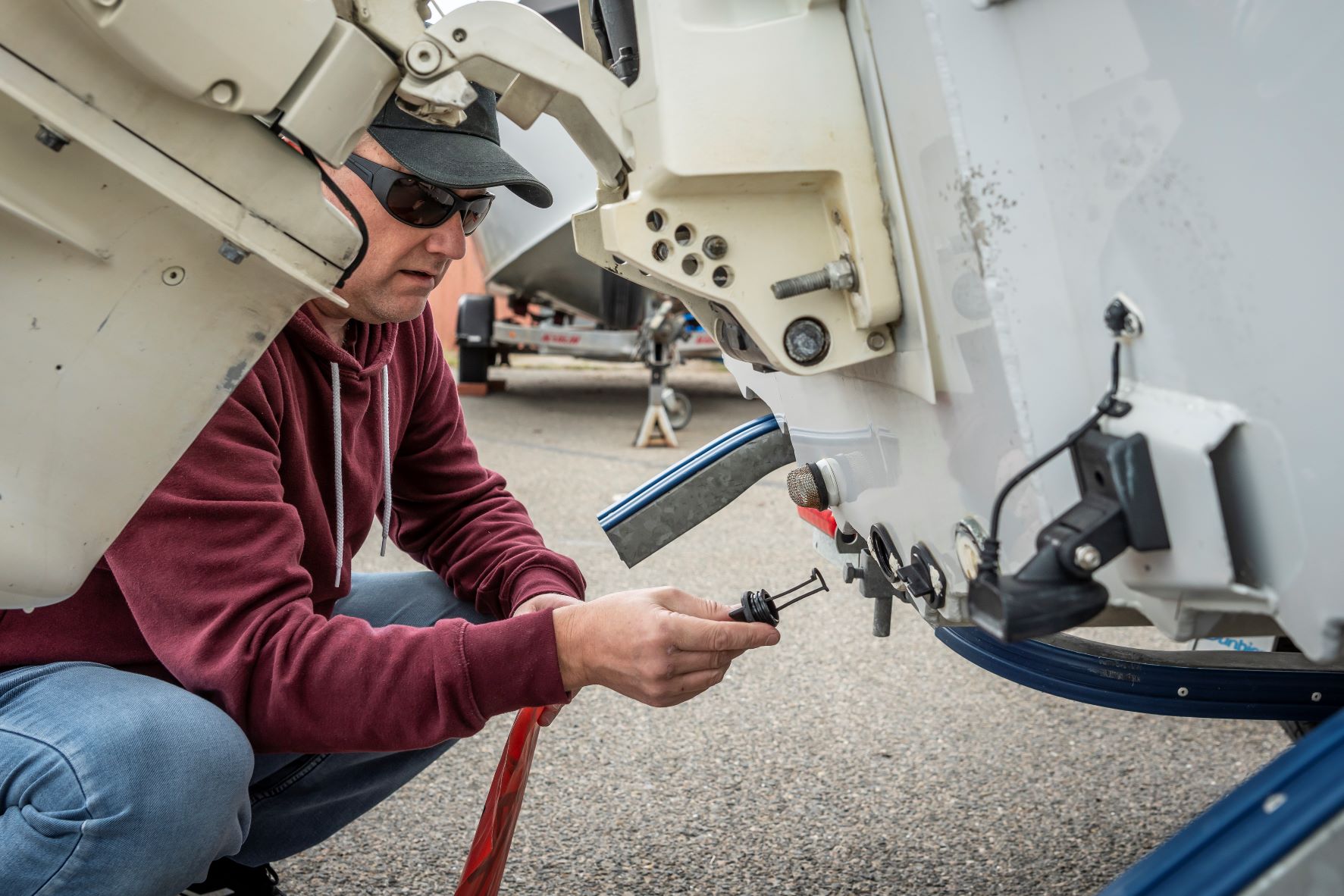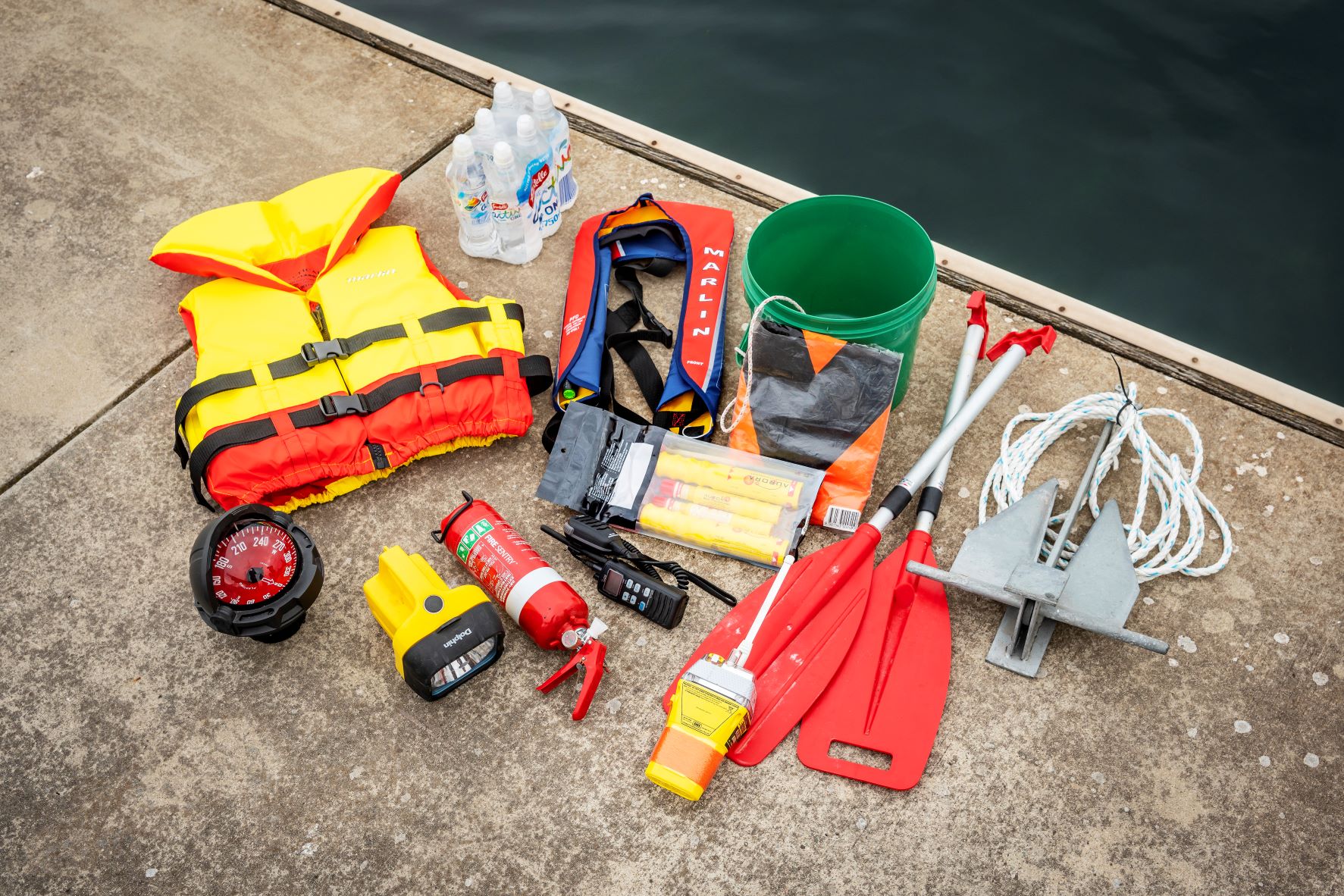Maintaining your vessel
Boat owners and skippers must make sure their boat is seaworthy and passengers are kept safe. Using an unseaworthy boat is an offence and the owner or skipper may be prosecuted. Boats can be unseaworthy not only because of their physical condition but also if the correct safety equipment is not on board.
An authorised person may direct the responsible person to retrieve an unseaworthy boat and fix it before using it again.
Before you go on the water, make sure your vessel and equipment are in good working order. If anything needs fixing or replacing, do it before you go.
The major causes of breakdown for powered vessels are engine failure, fuel shortage or contamination, mechanical failure and battery failure.
It is recommended that you learn how to:
- Change the filter and primer bowl.
- Clean and change spark plugs.
- Check the spark plugs are sparking.
- Check and replace fuses.
- Change the propeller.
- Check the battery.

Safety equipment
Check and maintain all your safety equipment and lifejackets on your vessel.
Check:
- Inflatable lifejackets have been serviced in line with the manufacturer’s instructions.
- Flares and fire extinguishers are not expired.
- EPIRB's are registered, not expired and battery is working.
- Torch batteries.
- Check and test marine radio (raise the antenna and aerials and check it’s working by making a test transmission to a volunteer marine rescue group).

Engine
It is recommended you have your engine fully serviced according to manufacturer's recommended service intervals. Familiarise yourself with the manufacturer’s manual and periodically run and flush the motor with fresh water.
For all powered vessels, check:
- Spark plugs, and make sure you have spares. It is recommended to replace spark plugs after 100 hours of use.
- Carry spare new spark plugs as replacements.
- Gearbox for leaks.
- Cooling water circulation is working by checking if water is squirting from where it's meant to when the engine is running.
- Gearbox:
- Change oil regularly.
- Check and refill gear case oil regularly.
- Check and service transmissions and lower units according to the manufacturer’s recommendations.
For personal watercraft (e.g.- Jeskis), check:
- Engine compartment for fumes – vent any fumes before starting the engine.
- Engine hood cover is securely latched.
- Throttle is in working order.
Battery
Flat batteries are a common cause of rescue call-outs. Always use marine batteries and keep your battery in the best possible condition. Batteries can fail after not being used for extended periods so always check it before heading out on the water.
Check:
- It is charged regularly and only to the recommended level (never overcharge).
- Is the battery the right strength to operate electrical equipment and start the engine.
- It is secured in brackets.
- Location is ventilated and vented before starting the engine.
- It has clean and secure terminals that are charged.
- Terminals should be greased regularly.
- Terminals and connections are tightly secured.
- Battery cells are topped up with distilled water.
- Turn off the power to the charger before disconnecting to reduce the risk of explosion.
Vessel structure
Check:
- Vessel structure for corrosion, cracks, and general wear and tear. Patch any minor cracks, as well as gouges or chips in fibreglass gel coat, more serious cracks should be repaired by a qualified boat repairer.
- The hull and decks - keeping them clean and properly waxed helps protect them.
- Fibreglass is regularly cleaned with fresh water and a nonabrasive soap if necessary, using a soft brush to help remove debris caught in crevices.
- Aluminium and stainless-steel parts are clean and polished using a good metal wax. They can corrode quickly near salt water.
- Check all screws, bolts, and other fittings.
Fuel
Before using any switches or engines, check:
- There are no petrol or LPG odours.
- Fuel and filter lines are clear and in good condition – filters can become clogged, and lines can harden with age and exposure.
- You have enough fuel and water – plan to use a third of your fuel for the trip out, a third for the trip back, and have a third in reserve for unexpected events.
- There are no leaks in fuel lines, fuel or oil tanks or the exhaust system.
- There are no faults in the electrical system and all components are clean.
- The boat is well ventilated to prevent carbon monoxide build up from exhaust systems.
- If your boat has not been used for a while, replace old fuel with new fuel.
Propellers and steering
The bushing of a propeller can fail, especially if it has hit sand or rocks.
Check:
- Steering cables and connections are in good working order.
- Shafts and propellers are clean and in working order.
- Propeller nut and shear pin or split pin.
- The propellor shaft and remove any fishing line or other materials that may affect the performance.
- You are carrying a suitable spanner to undo the propeller nut.
- You have a spare propeller and shear pin / split pin/s if needed.
LPG cylinders and appliances
If your boat has LPG burning appliances, check:
- Cylinders and appliances are suitable for marine use.
- Cylinders have been inspected and serviced by a licensed gas fitter.
- Equipment and hoses are in safe working order.
- Gas storage bottles are located in a well-ventilated space and vented outside of the vessel.
Water pumps and bilges
If the vessel has more than one compartment, enough pumps must be carried to be able to drain each compartment.
Check:
- Bilges – if there's more bilge water than usual, find out why and fix it.
- Self-draining holes are clear.
- You have the bung and it's in place.
- Replace the engine water pump if you've been out in the shallows stirring sand or mud, or if you have not used the boat for a while.
- The water is being discharged from the exhaust system and from the tell-tale, where applicable, when the motor starts.
- For water leaks regularly, it is helpful to have a water pressure gauge on motors of 50 horsepower (hp) or more.
- For a personal watercraft, check that the pump or intake area is free of debris.
Lights
Check:
- Lenses are clean and clear.
- Navigation lights are in working order.
Ropes and lines
Check:
- Ropes and lines are in good condition.
- Cleats, bitts and test washers and pads on bolts securing the cleats.
- Shackles are ‘moused’ (wired) or otherwise prevented from undoing.
- Ropes are stored ready for use out of the sun when not in use – hardness and roughness in feel and fading colour are signs of UV damage.
Anchors
Check:
- Do you have the right anchor on board?
- Shackles and hard eyes and chain in the anchor cable.
- The anchor is rigged, stowed and ready for use.
Kill switch
Check:
- If your vessel or personal watercraft has an engine kill switch, make sure you have the correct lanyard.
Spare parts and tools
An effective tool kit should include, at a minimum:
- An engine manual.
- Screwdrivers (Phillips and flathead).
- Shifting spanner and pliers - long-nose pliers can be useful.
- A set of open-end or ring spanners.
- A suitable spanner or other tool to remove spark plugs.
- De-watering spray, spare oil and a funnel or siphon hose for oil and fuel.
- A roll of waterproof electrical tape.
- Starter cord.
- A length of soft wire.
- A wire brush.
- A sharp knife.
- Spare items such as:
- spark plugs and fuses (new)
- batteries for torch and radio
- ‘O’ rings for the fuel connector
- bung – propeller nut and socket, washer and split pins
- fuel line
- ‘D’ shackle
- key, on a lanyard or similar.
Recommended boat maintenance schedule
| Pre-season | Mid-season | Post-season | |
|---|---|---|---|
| Fuel tank |
|
|
|
| Fuel line |
|
|
|
| Fuel filter |
|
|
|
| Fuel system (if you suspect an ethanol fuel blend has been used) |
|
|
|
| Batteries |
|
|
|
| Engine |
| ||
| Pull cord (if fitted) |
| ||
| Wiring |
| ||
| Spark plugs |
|
| |
| Cylinders |
| ||
| Moving parts |
|
|
|
| Power unit |
|
| |
| Cooling system |
|
|
|
| Propeller |
|
|
|
| Outer surface |
|
|
|


